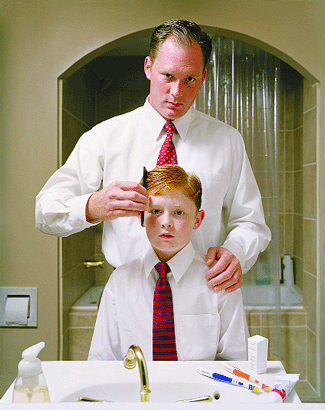Another polemical exhibition of American art
Out in front of the museum stands “Peace Tower,” 2006, which Mark di Suvero and Rirkrit Tiravanija collaborated on with about 300 other artists invited to recreate the “Artists’ Tower for Peace”—first erected in Los Angeles in 1966 to protest the Vietnam War. Well intended, the tower seems impotent in the face of a saccharine or silent chattering journalist class, a populace that seems to acquiesce to the desires of business, and an administration that does as it pleases. “Peace Tower” does, however, hint at a theme in this Whitney Biennial—artists working together. The ideas they explore are often powerful; other times they seem like adolescent temper tantrums.
Perhaps the most compelling part of the Biennial is on the fifth floor in a display titled “Down By Law.” Curated by the Wrong Gallery, this collection of works by 54 artists explores the “dark heroes of the American dream.” Works range across generations and include Paul Cadmus’ watercolor “To The Lynching” (1935), Tim Rollins & K.O.S.’ “By Any Means Necessary: Nightmare” (1986), and Andres Serrano’s infamous “Piss Christ” (1987) depicting a crucifix submerged in urine. Two potent works in this series are David Wojnarowicz’s photostat “One Day, This Kid” (1980), and Felix Gonzalez-Torres’ “Untitled, Death by Gun,” both of which use text to draw the viewer into the work, and convey an unnerving, memorable sense of empathy. The gallery is hung salon-style and provides a clarion call to American culture that echoes artist Sam Durant’s astutely titled work “We Are All Outlaws in the Eyes of America” (2004).
Unfortunately the remainder of the exhibition dithers all over the spectrum of globalized culture, grasping at straws to conceptually tie the exhibition together.
The best of the lot includes Ryan Trecartin’s laugh out loud video, “A Family Finds Entertainment;” Jamal Cyrus’ defiant, subversive drawings and sculptures, especially “The End Of My Beginning;” Angela Strassheim’s photograph of a father grooming his son from her series “Left Behind;” and paintings by Chris Vasell and Rudolph Stingel.
“Day For Night,” as described by the catalogue, attempts to examine the “schizophrenic situation…(of) two realities that discomfortingly coexist: one of anxiety, exasperation, and despair: and another of exuberance, energy, and wishful thinking.” In the end the curators, Chrissie Iles and Philippe Vergne, did the impossible job of collecting contemporary American artists under one roof with the laudable goal of attempting “to capture the artifice of American culture, in all its complexity.”
The result feels like a hodge-podge of politics, aesthetics, and a naval gazing art world.
The sense of artists “working,” as Vergne has described, “in a space between day and night, between the history of forms and the forms of history… [where] many things are called into question or obscured” is a key theme. And yet even this idea was spread thinly, conveyed in part by the inclusion of Critical Art Ensemble and The Bureau of Inverse Technology, and others exploring group process. Yet, there are many more artists, collectives, and endeavors that could have represented this idea of working and social collaboration more deeply.
gaycitynews.com


































